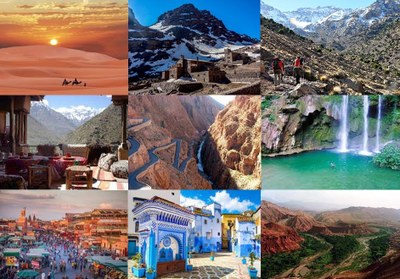Explore Morocco’s Ancient Cities, Oases and Desert Dunes, and Trek the High Atlas to Mt Toubkal
Morocco: cities with a vibrant mix of the ancient and the modern; colorful souks (marketplaces); rich spices and mint tea; warm beaches; amazing food; and leisurely camel rides amid the towering sand dunes of the Sahara. And for strong trekkers and seekers of ancient cultures in their most untouched form, the High Atlas Mountains, home to some of North Africa’s most remote and ancient villages and populations, provide interesting and challenging trekking between remote fortified towns and welcoming Berber guest houses.
Morocco is the northwesternmost country in Africa and an integral part of the Arab world. The only constitutional monarchy in North Africa, the country is rich in history and culture, and for many people, Morocco has always been the gateway to Africa, and Moroccan culture is a vibrant mix of various cultures.
Morocco’s cities are famed for their cultural variety and uniqueness, including:
- Marrakesh, the "Red City" and most prominent former imperial capital. Wander the lively souqs, admiring the old gates and defense walls, see the Saadian Tombs, the remnants of the El Badi Palace and visit the Koutoubia Mosque with its 12th century minaret. And at night don’t miss its Jamaa el-Fnaa, the largest square in Africa, features incredible food stalls, Arabic story tellers, magicians and Chleuh dancers.
- Fez, once Morocco's capital and another imperial city with a labyrinth of narrow Medieval streets, a huge medina, beautiful city gates, the ancient University of Al-Karaouine, and and the Bou Inania Madrasa.
- Meknes, often called the "Versailles of Morocco" with Its lovely Spanish-Moorish style centre surrounded by tall city walls with impressive gates - a 17th century blend of European and Islamic cultures.
- Chefchaouen, a humble town with a picturesque medina set against the dramatic backdrop of the Rif Mountains, is filled with white-washed homes with distinctive, powder-blue accents, and the call to prayer rings out of several mosques around the town in chorus.
The High Atlas Mountains, known among the locals as ‘Idraren Draren’ (Mountains of Mountains), are North Africa’s highest mountain range. They run across Morocco for about 1000 km and separate the mild Atlantic and Mediterranean coastlines from the harsh Sahara desert in the south, and are a regular destination for mountain hikers, ski enthusiasts, or travelers interested in the indigenous Berber culture found throughout its many peaks and valleys With an elevation of 4,167 m (13,668 ft), Toubkal in southwestern Morocco is the range’s highest peak. These mountains are stark and arid, dotted with burnt-orange rock, pines, cedars, snow-capped peaks and lush green valleys, interspersed with the clay homes of the local Berber population. Trekkers through the High Atlas have the opportunity to ‘wild-camp’ but may also spend the night with Berber families in guest houses, true to their traditions and nomadic way of life but also very welcoming to visitors! Note that, because the High Atlas extend to over 13,000 feet in altitude, any trek needs to consider the potential for altitude illness and proper preventive steps.
The Berbers are the original inhabitants of these ranges – they proudly call themselves Amazigh (“free people” or “noble men) and have a history as an indigenous people in western North Africa that goes back at least to 10,000 BC. Some continue to reside in clay huts and caves like their ancestors, while others live in the small hamlets in the valleys. Today their nomadic lifestyle focuses on farming with camels, horses and donkeys. The Berbers have resolutely preserved their culture through oral storytelling and song. And their traditional belief systems have become an inextricable part of their lives. As you amble through villages, you will hear strains of the rhythmic beat of drums and flutes wafting through, to which the villagers dance to, in celebration and ritual. And the centuries of weaving tradition also mean some of the world’s best carpets, their distinctive simple geometric designs a visual representation of the many stories passed from one generation to the next.
The Sahara: Few places on Earth compare to the incredible landscapes of the Sahara Desert. Running roughly north-south along Morocco’s eastern border with neighboring Algeria, the Sahara Desert is the world’s largest hot desert covering an area roughly the size of the entire United States. Many travelers visit Morocco specifically with the intention of venturing off into the desert to ride a camel through its towering dunes, spend a night under the stars, and wake up to incredible sunrises.
Resources for Trekking and Touring Visitors
Local guides and drivers are available for anything from a day tour to an extended driving, touring and trekking adventure across Morocco – some from multi-national tour operators, others from small local operators, and many in between. A google search will yield many options; as always, be sure to check references! You can also self-drive and backpack through the area. Note that much of the driving to the High Atlas and Sahara is over mountain passes and through basic, sometimes very slow and rugged, highways and rural roads. Even drives of seemingly short distances from Marrakesh or Fez to the High Atlas or the Sahara will take hours to a full day of driving one-way. Budget your time accordingly.
- Suitable Activities: Global Adventures, Backpacking, Day Hiking
- Seasons: Year-round
- Weather: View weather forecast
- Land Manager: Land Manager Varies
- Parking Permit Required: see Land Manager
- Recommended Party Size: 12
- Maximum Party Size: 12
- Maximum Route/Place Capacity: 12
There are no resources for this route/place. Log in and send us updates, images, or resources.
